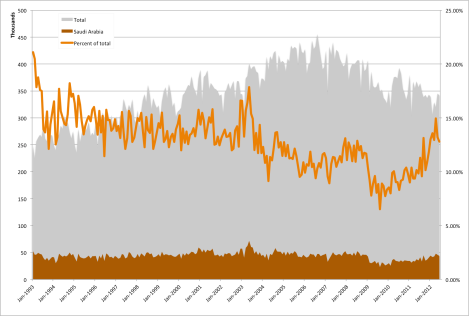Here’s a good reason for America to wean itself off of oil, particularly from foreign countries: As foreign economies expand, they’ll increasingly need to use their oil domestically.

Camels in Saudi Arabia, 1982. (Photo by Brian Harrington Spier.)
Case in point, Saudi Arabia, which may become a net oil importer within the next two decades. From the Telegraph:
The Kingdom is the world’s largest oil producer, accounting for about 13pc of global supply, but it may need to use a growing share of its production for power generation to meet rising electricity demand, Citi said.
Its export capacity could steadily reduce and, “if nothing changes, Saudi may have no available oil for export by 2030”, Citi analyst Heidy Rehman wrote.
Saudi Arabia consumes 25pc of its oil output and oil accounts for about 50pc of its electricity production. With peak power demand rising by about 8pc per year, the nation is aiming to more than double its power capacity by 2032 through new nuclear and solar installations.
Nuclear is not an ideal option, given the critical challenges of keeping a reactor cool.
Saudi Arabia is the United States’ third-largest source of oil after Canada and the Persian Gulf states. In June, Saudi oil comprised about 12.8 percent of all our imports. And as you can see in the graph below, the percent of our imported oil that we get from Saudi Arabia is again growing, after a low during the recession.

The left axis indicates thousands of thousands of barrels. The grey area is all U.S. imports; the dark orange area, Saudi oil. The orange line is pegged to the right axis, showing the share of all imports which is Saudi. (Click to embiggen.)
There are two challenges here for the U.S. Less Saudi oil on the market means less supply, which means higher prices. And less Saudi oil to import means an increased reliance on other sources — or curtailed demand. The new U.S. auto efficiency standards will require a near-doubling of fuel economy by 2025, which is projected to drop consumption by 2 million barrels a day — just over what we now import from Saudi Arabia.
The U.S. will have to adjust its imports and consumption, which won’t be easy. But for Saudi Arabia, switching from earning money off its oil to burning the oil itself is a massive problem.



